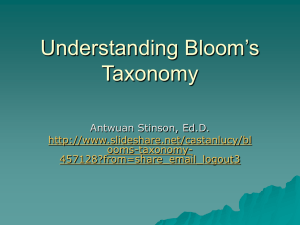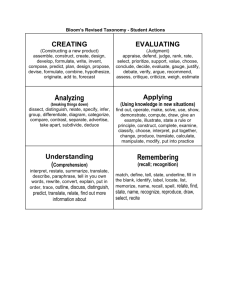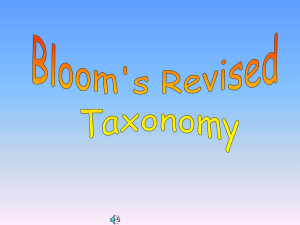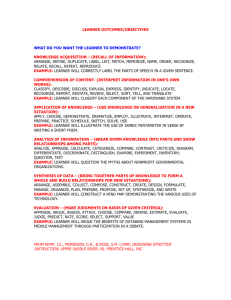Literacy Hats Parent Workshop
advertisement
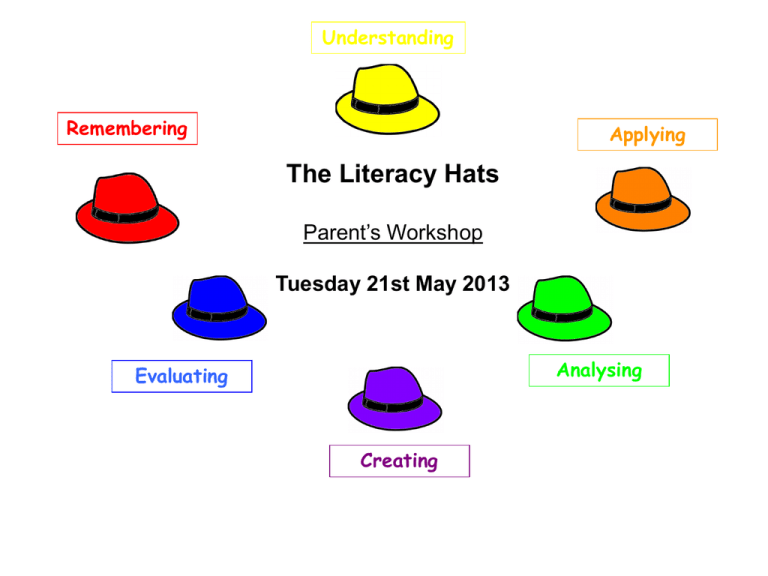
Understanding Remembering Applying The Literacy Hats Parent’s Workshop Tuesday 21st May 2013 Analysing Evaluating Creating Standards and expectations What do we mean by Higher Order Thinking? Higher Order Thinking (HOT) is complex thinking that goes beyond basic recall of facts. It includes analysis, evaluation and invention, enabling children to retain information and to apply problem-solving solutions to real-world problems. Why teach Higher Order Thinking Skills? As outlined in the Curriculum for Excellence, ‘Skills for learning, skills for life and skills for work’ (2009), “Thinking skills across learning Skills in thinking relate closely to skills in literacy and numeracy. Thinking allows learners to explore text and information of all kinds critically and to use them purposefully. In Improving Scottish Education 2005-2008, HMIE states: ‘Curriculum for Excellence sets high expectations of rigour. This means that teachers should plan consistently for appropriate pace, challenge, depth and progression and consciously promote the development of high order thinking skills.’ “ Bloom’s Taxonomy I can use the information to build new ideas I can say what I think about the information and back up my opinion I can break down the information to understand it better I can use the information in a new way I can explain the ideas in the information I can remember facts about the information Creating How could you change the plot...? Evaluating What would you say is the importance of…? Analysing Applying Understanding Remembering What evidence can you find to…? What questions would you ask of…? How could you say that in your own words…? Where does it say…? When/why/how did…? By using Bloom’s Taxonomy to pre-plan questions and activities, Teachers can engage students, helping them to become analysers of information and creators of new ideas. Remembering The learner is able to recall, restate and remember learned information. – Recognising – Listing – Describing – Identifying – Retrieving – Naming – Locating – Finding Can you recall information? Potential Activities and Products • • • • • • • • Make a story map showing the main events of the story. Make a time line of your typical day. Make a concept map of the topic. Write a list of keywords you know about…. What characters were in the story? Make a chart showing… Make an acrostic poem about… Recite a poem you have learnt. QUESTIONS • • • • • • • • • What happened after...? How many...? What is...? Who was it that...? Can you name ...? Find the definition of… Describe what happened after… Who spoke to...? Which is true or false...? Understanding The learner grasps the meaning of information by interpreting and translating what has been learned. – Interpreting – Exemplifying – Summarising – Inferring – Paraphrasing – Classifying – Comparing – Explaining Can you explain ideas or concepts? Potential Activities and Products • • • • • • • • • • • • • • Write in your own words… Cut out, or draw pictures to illustrate a particular event in the story. Report to the class… Illustrate what you think the main idea may have been. Make a cartoon strip showing the sequence of events in the story. Write and perform a play based on the story. Write a brief outline to explain this story to someone else Explain why the character solved the problem in this particular way Write a summary report of the event. Prepare a flow chart to illustrate the sequence of events. Make a colouring book. Paraphrase this chapter in the book. Retell in your own words. Outline the main points. QUESTIONS • • • • • • • • • • Can you explain why…? Can you write in your own words? How would you explain…? Can you write a brief outline...? What do you think could have happened next...? Who do you think...? What was the main idea...? Can you clarify…? Can you illustrate…? Does everyone act in the way that …….. does? Applying The learner makes use of information in a context different from the one in which it was learned. – Implementing – Carrying out – Using – Executing Can you use the information in another familiar situation? Potential Activities and Products • • • • • • • • • • • • • • Construct a model to demonstrate how it looks or works Practise a play and perform it for the class Make a diorama to illustrate an event Write a diary entry Make a scrapbook about the area of study. Prepare invitations for a character’s birthday party Make a topographic map Take and display a collection of photographs on a particular topic. Make up a puzzle or a game about the topic. Write an explanation about this topic for others. Dress a doll in national costume. Make a clay model… Paint a mural using the same materials. Continue the story… QUESTIONS • • • • • Do you know of another instance where…? Can you group by characteristics such as…? Which factors would you change if…? What questions would you ask of…? From the information given, can you develop a set of instructions about…? Analysing The learner breaks learned information into its parts to best understand that information. – Comparing Can you break – Organising information into – Deconstructing parts to explore – Attributing understandings – Outlining – Finding and – Structuring relationships? – Integrating QUESTIONS • • • • Potential Activities and Products • • • • • • • • • • • • • • • Use a Venn Diagram to show how two topics are the same and different Design a questionnaire to gather information. Survey classmates to find out what they think about a particular topic. Analyse the results. Make a flow chart to show the critical stages. Classify the actions of the characters in the book Create a sociogram from the narrative Construct a graph to illustrate selected information. Make a family tree showing relationships. Devise a roleplay about the study area. Write a biography of a person studied. Prepare a report about the area of study. Conduct an investigation to produce information to support a view. Review a work of art in terms of form, colour and texture. Draw a graph Complete a Decision Making Matrix to help you decide which breakfast cereal to purchase • • • • • • • Which events could not have happened? If. ..happened, what might the ending have been? How is...similar to...? What do you see as other possible outcomes? Why did...changes occur? Can you explain what must have happened when...? What are some or the problems of...? Can you distinguish between...? What were some of the motives behind..? What was the turning point? What was the problem with...? Evaluating The learner makes decisions based on in-depth reflection, criticism and assessment. – Checking – Hypothesising – Critiquing Can you justify a – Experimenting decision or – Judging course of action? – Testing – Detecting – Monitoring Potential Activities and Products • • • • • • • • • • • Write a letter to the editor Prepare and conduct a debate Prepare a list of criteria to judge… Write a persuasive speech arguing for/against… Make a booklet about five rules you see as important. Convince others. Form a panel to discuss viewpoints on…. Write a letter to. ..advising on changes needed. Write a half-yearly report. Prepare a case to present your view about... Complete a PMI on… Evaluate the character’s actions in the story QUESTIONS • • • • • • • • • • • • • • Is there a better solution to...? Judge the value of... What do you think about...? Can you defend your position about...? Do you think...is a good or bad thing? How would you have handled...? What changes to.. would you recommend? Do you believe...? How would you feel if. ..? How effective are. ..? What are the consequences..? What influence will....have on our lives? What are the pros and cons of....? Why is ....of value? What are the alternatives? Who will gain & who will loose? Creating The learner creates new ideas and information using what has been previously learned. – Designing Can you – Constructing generate new – Planning products, ideas, – Producing – Inventing or ways of – Devising viewing things? – Making Potential Activities and Products • • • • • • • • • • • • Invent a machine to do a specific task. Design a robot to do your homework. Create a new product. Give it a name and plan a marketing campaign. Write about your feelings in relation to... Write a TV show play, puppet show, role play, song or pantomime about.. Design a new monetary system Develop a menu for a new restaurant using a variety of healthy foods Design a record, book or magazine cover for... Sell an idea Devise a way to... Make up a new language and use it in an example Write a jingle to advertise a new product. QUESTIONS • • • • • • • • Can you design a...to...? Can you see a possible solution to...? If you had access to all resources, how would you deal with...? Why don't you devise your own way to...? What would happen if ...? How many ways can you...? Can you create new and unusual uses for...? Can you develop a proposal which would...? Secure Has achieved a breadth of learning across almost all of the experiences and outcomes for the level, including any significant aspects of the curriculum area Has responded consistently well to the level of challenge set out in these experiences and outcomes Has moved forward to more challenging learning in some aspects. Has applied what he/she has learned in new and unfamiliar situations. Developing Has started to engage in the work of the new level Is beginning to make progress in an increasing number of outcomes across the breadth of learning described in the experiences and outcomes for the level. The Learner.. Consolidating Has achieved a breadth of learning across many of the experiences and outcomes for the level Can apply what he/she has learned in familiar situations Is beginning to undertake more challenging learning and to apply learning in unfamiliar contexts.

